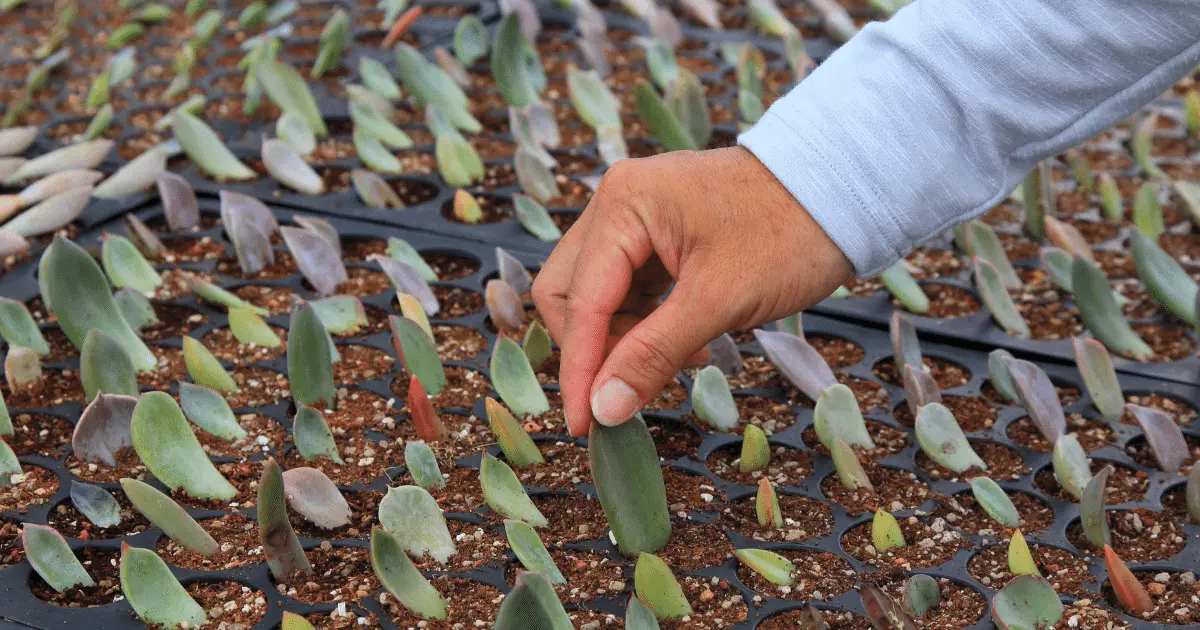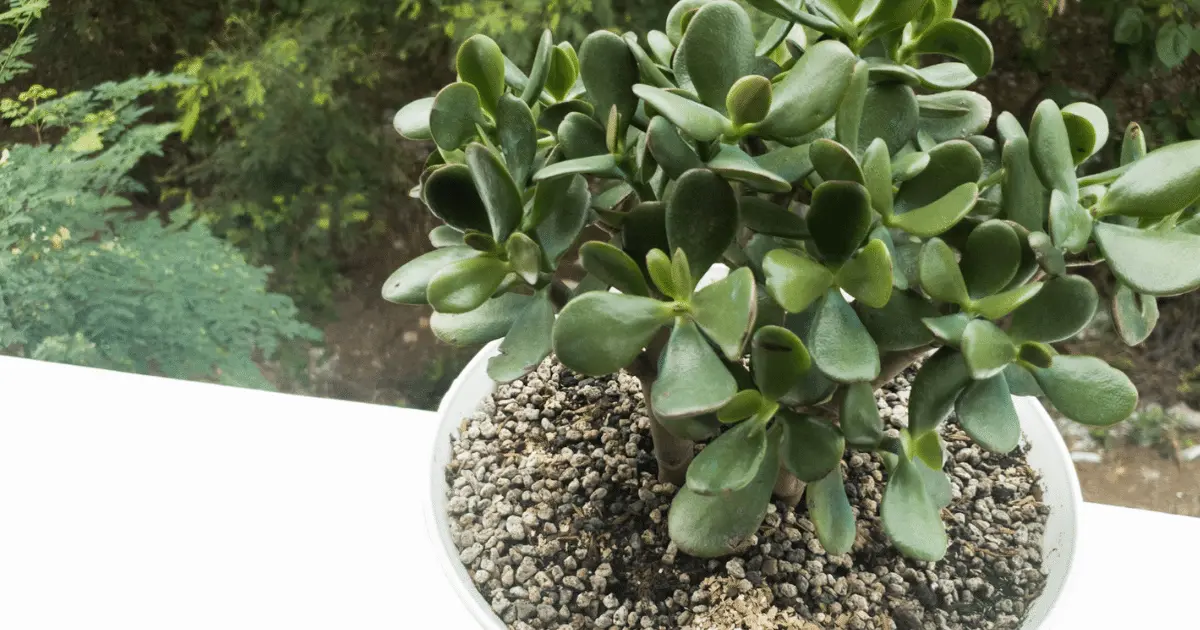Crassula ovata, or Jade plant, ranks among the most widely propagated garden plants in homes and offices.
Commonly called the Money Plant, Money Tree, or Lucky plant, Jade plants are native to the Eastern Cape and KwaZulu-Natal regions of South Africa and modern-day Mozambique.
Jade plants are now popularly grown worldwide; there’s so much love for them due to their enduring flush, luxuriant, gleaming foliage that makes them the perfect indoor ornamental plants.
Propagating Jade Plants

Jade plants are a lifetime companion when propagated. They can live for over 100 years, measuring more than 8 feet in height; repotting them is vital to their longevity and rejuvenation.
They’re quite resilient; you can propagate them by dividing a mature plant or rooting stem and leaf cuttings, and they can be fully propagated within two weeks to two months of rooting.
Propagating Jade Plants by Division
One of the easiest methods of growing new Jade plants is by easily dividing an older plant. I do a lot of division for my Jade plants to prevent them from growing into mature wild trees.
It would help if you kept repotting your Jade plants to maintain them as garden plants because older plants easily transform into proper Jade trees, which can’t be left indoors anymore.
To divide a mature Jade plant, identify which stems are traveling away from the mother plant. If these stems are well attached to the roots and bear parts of the leaves, they can be separated and propagated as new plants.
Once you’ve identified your potential stems, pull out the Jade plant from its pot and gently brush the soil from the roots. You can use your fingers to comb through the roots to make them loose.
Next, separate the branching stem from the plant, ensuring each part gets its roots and leaves. You can now cut off the mature plant’s stem and re-pot both separately.
Division is a great way to make an older Jade plant more active and lively again; only ensure the cut stems are properly healed before replanting.
Propagating Jade Plants by Cuttings

The most widely used method of Propagating Jade plants is by rooting cuttings from an older plant in water or a Potting soil mix.
Jade plants are well propagated using cuttings from their stems or leaves, and they can be rooted either in water or a Potting soil mix.
Select healthy-looking stems to make your cuttings; each stem must have well-developed nodes and fully-grown leaves. Use a sharp, clean knife or scissors to neatly cut off the stems and arrange them on a dry, warm surface.
Remove all leaves at the bottom of the stems leaving only the leaves at the top edges. Each leaf should have long stalks for root development.
You can divide the longer stems into smaller sections, but each stem cutting has to be up to three inches to root properly. Your stem and leaf cuttings should heal for a day or two before rooting them.
Rooting your Jade Plant Cuttings in Water
It takes longer to root your cuttings in water, but the plus to this method is that you can visibly monitor the whole root development process.
Begin by preparing your glass jar or transparent container by pouring water up to 2/3 its volume.
Next, place the calloused cuttings into the glass jar and position it where there’s plenty of indirect sunshine. You get to determine how thick your Jade plants will be by how many cuttings are rooted in the glass jar.
Rooting in water takes about four or five weeks before the cuttings are due for transplanting. Always replace the water in the jar regularly, not less than weekly, to deter fungal and bacterial growth and keep the medium fresh.
Rooting Jade Plant Cuttings in a Potting Medium

Your Jade plant cuttings will root faster in a pot than in water, although you’ll have no idea what’s going on until the first leaves appear. You could opt for a soil-based Potting mix or a soilless potting blend to root your Jade cuttings.
Once the pots are filled with the Potting mix, insert your calloused cuttings on the surface area, ensuring they’re within one inch deep.
For the leaf cuttings, spread them evenly on the surface of the potting mix. Water thoroughly the first time after planting the cuttings and ensure the excess water completely drains out.
You should use only water sparingly afterward; focus on keeping the medium warm and moist until the roots are well developed. The potted cuttings should be positioned to receive adequate Indirect sunlight, and the cuttings will begin to root in less than three weeks.
Sunning your new Jade Plants
Placing them under the brilliance of a sunny day for up to four hours at a go will do a lot of good.
They look their best when propagated in a well-illuminated environment, growing radiantly healthy-looking foliage.
You’ll want to keep them where they can access as much indirect sunshine as possible. The windows facing the South or East direction in the building are best.
Watering the Tender Jade Plants
Jade plants can be left in damp soil potting for a short time; excess water in the soil could lead to the rotting of the leaves.
It’s also important to keep them watered and not starved of moisture. To maintain a balance, only water them when the topsoil is completely dry, especially in their growing season.
They are best propagated between early spring and late summer, and the soil should be kept warm and moist in these seasons.
They require much less watering during winter when they appear to be dormant. It would be best if you only watered them once in two or three weeks during winter.
Jade plants have very little need for misting or spraying; you should only water them from the roots.
Practice deep soil watering when the top soil looks dried and crumbly; pour excess water into the soil pot and place it on a flat surface until all the water drains. The next watering cycle should be when the topsoil looks dry again.
Best Potting Mix for Jade Plants
Jade plants are best rooted in a homemade potting mix comprising a blend of half-part perlite (or vermiculite in some cases) and part of potting soil.
Adding perlite to your Potting Mix greatly improves the soil percolation and aeration. If this seems too much trouble, there are commercial potting mixes to try out, such as succulents soil mix and cactus potting mix.
Toxicity of Jade Plant
It would help if you took great precautionary measures while manoeuvring Jade plant cuttings because the fluids and spikes could be mildly toxic when in contact with the body.
Wearing a nice pair of gloves should offer all the protection you need. Careful about any cats or household pets coming too close; they might get serious allergic reactions.
Jade plants are super easy to propagate; even newbie propagators won’t have too much trouble adding new pots to their gardens.
They’re much desired for their tenacious adaptability to almost any home environment. You’ll also benefit from their many medical applications in treating diarrhea, indigestion, nausea, etc.
They are wonderful air purifiers, removing toxic gases such as carbon dioxide and dioxins from the atmosphere. You won’t need to worry about giving them special water or soil treatment, which greatly improves your chances of success.
